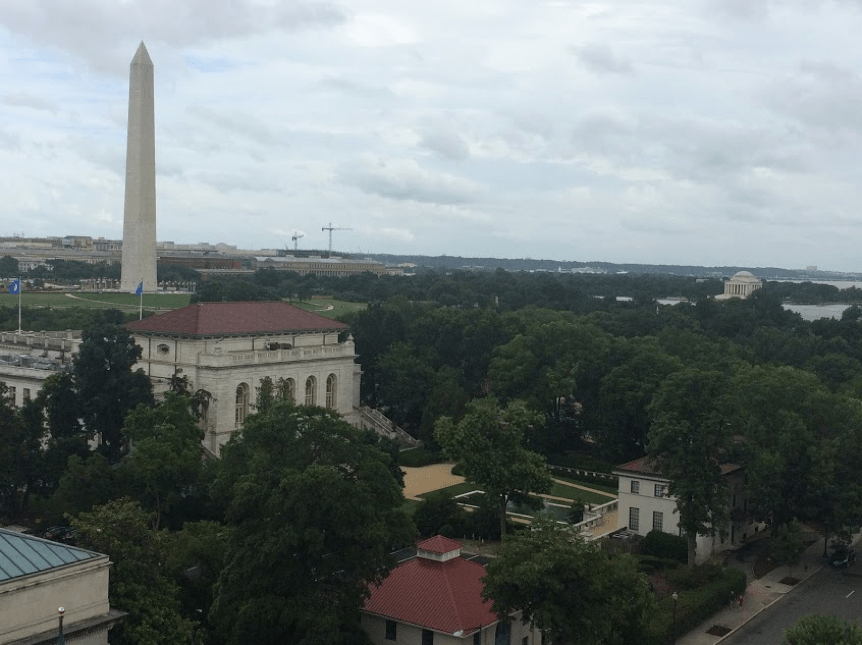Dispatches from Washington, DC
by: Megan Bailey
Trained as an archaeologist, I normally spend my summers engaged in some type of fieldwork, whether it’s excavating a historic site or cleaning, identifying, and processing artifacts. This summer, however, I’m spending most of my time in an office building, sitting in front of a computer. This may sound uninteresting, but to the contrary, I’ve found plenty of things to get excited about.
I’m interning in the Cultural Resources Office of Interpretation and Education at the NPS headquarters in Washington, DC (usually referred to as WASO). Having worked in a national park before, I thought I knew the ins and outs of how the NPS operated…but now that I’m at the main building, I’m learning so much about how NPS policies are crafted and enacted, how priorities are developed, and, in short, why the NPS does what it does. Because I’m a policy nerd, I love seeing this process in motion — how the laws and current administration dictate priorities, which are then crafted into policies at WASO, which are then handed down to the NPS regional offices, which oversee their execution at individual parks, sites, and monuments (admittedly, this is an oversimplified description).
So, what is my role in all this? The WASO Cultural Resources Office of Interpretation and Education is spearheading the national coordination of the 19th Amendment Centennial Commemoration, which will take place in 2020 (ratified in 1920, the 19th Amendment gave (white) women the right to vote). I am assisting with these efforts by researching the history of the 19th Amendment as well as the 15th Amendment (which gave Black men the right to vote in 1870) and connecting these histories to stories, places, and people within national parks. I will be writing a series of articles on the topic of voting rights– addressing citizenship, civic engagement, activism, and other aspects of the struggle for universal suffrage– and will publish these articles on the NPS website.
After spending MANY years in school (I earned a B.A., M.A., and PhD., all in Anthropology), I am thrilled to have the opportunity to exercise my academic skills in the “real world.” The NPS is faster-paced than academia and has different philosophies and values, so that required some adjustment on my part, but overall I am enjoying my work, where I must use the research skills I picked up in graduate school and apply them to topics that I know very little about. In addition, my research has taken me to all kinds of places — the Library of Congress and the National Archives, for example– and I am constantly amazed by the incredible historical resources we have in the U.S.
Currently, I am at the stage in the research process where I have piles of books everywhere, tons of notes strewn about my desk, and a million tabs open on my computer. In a couple of weeks I should be able to report on some of my findings, but right now I’m simply trying to organize the overwhelming amount of resources I’ve collected. This chaotic scene is not very photogenic, so instead I will focus on my office building for the visual portion of this blog post.

Dept. of the Interior Building at night, ca. 1930-1945, courtesy of the Tichnor Brothers Collection at the Boston Public Library.
Constructed between 1935 and 1936, the Main Interior Building houses the headquarters of the Department of the Interior and all of its federal agencies, such as the NPS, the Bureau of Land Management, and the Bureau of Indian Affairs. The building is enormous, spanning two city blocks, and is a maze of corridors inside, housing hundreds of offices.
One of my favorite things about this building is that there is art everywhere. For example, there are 26 prints of the 200+ images that the photographer and conservationist Ansel Adams produced for the Interior Mural Project of 1941. These gorgeous photographs document Interior-managed resources, such as parks and reclamation projects.

“Formations along the wall of the Big Room, near Crystal Spring Home, Carlsbad Caverns National Park,” New Mexico, by Ansel Adams, ca, 1933-1942.

Full View of Cactus and Surround Shrubs, “In Saguaro National Monument,” Arizona, by Ansel Adams, ca. 1933-1942,

View of Valley from Mountain, “Canyon de Chally” National Monument, Arizona, by Ansel Adams, ca. 1933-1942.
The DOI building also features over 40 murals painted by a variety of artists during the Great Depression as part of President Franklin D. Roosevelt’s New Deal.
In addition to paintings and photographs, the building also has several marble sculptures.
No tour of the DOI building would be complete without a view from the rooftop. From there, one can easily see noteworthy structures and monuments such as the White House, the Jefferson Memorial, and the Washington Monument.






